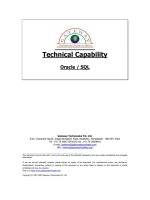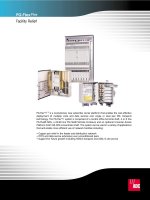Tài liệu High-Density Solution docx
Bạn đang xem bản rút gọn của tài liệu. Xem và tải ngay bản đầy đủ của tài liệu tại đây (625.94 KB, 3 trang )
FIBER OPTICS
FIBER OPTICS
O
ne night in 1996, an unusually hard rain sent a wall
of water onto the campus of Colorado State Univer-
sity (CSU) in Fort Collins, Colo. The flood gutted
the ground floor and basement levels of 14 buildings, sub-
merging main distribution frames in each building. Panels
were ripped from walls, rooms filled with mud, patch cords
floated away, and fiber optic cable filled with water. No one
on campus was hurt but, needless to say, the network was
down.
At the time of the flood, CSU used a variety of fiber pan-
els and connectors from different manufacturers for sup-
porting the data, video and environmental control
applications that served over 30,000 students, faculty and
guests at the university. With much of the network infra-
structure badly damaged, CSU turned the disaster into an
opportunity to improve the network and standardize with
one vendor for fiber optic network components.
There was a hitch in the new network design, however.
With the disaster of the flood still fresh in their minds, CSU
network managers decided to consolidate the main fiber dis-
tribution frame in a new and more secure, yet smaller, space
in the already crowded computer room. With less space for
the main fiber frame and a forecast for doubling active net-
work connections to more than 25,000 within five years,
CSU managers faced a decision: how to aggregate the fiber
plant in less space and allow room to at least double capac-
ity without adding floor space.
After evaluating many solutions, CSU chose ADC fiber
products, including the new LX.5™ small form factor (SFF)
connector and adapter. With the SFF, two single circuit
fiber terminations are housed in a single adapter that fits in
BY MICHAEL S. MCCAHEY
High-Density
Solution
High-Density
Solution
Cable Management Required for
Small Form Factor Fiber
Connectors and Adapters
Colorado State University in Fort Collins where a 1996 flood was
a catalyst for change in the university’s network design.
the same footprint as the single fiber
SC connector and adapter, allowing
CSU to double the density of fiber ter-
mination equipment. And because the
SFF and SC adapters feature identical
footprints, CSU was even able to reuse
fiber termination equipment, saving
time and money by avoiding some
unnecessary equipment upgrades.
“A small form factor connector was
the perfect choice for us,” said Randy
Simon, the CSU telecommunications
specialist charged with installing and
maintaining the fiber plant. “In our
new network design, we were given
very limited space. We now have a
high-density solution that won’t
require more floor space as we grow.”
In evaluating small form factor solu-
tions on the market, Simon preferred
an SFF designed for single circuit
access instead of those designed only
as pairs of fibers, products aimed pri-
marily to handle future desktop appli-
cations. The reason was simple. He
determined that a single circuit design
would cut down on maintenance time
and reduce network downtime. Also,
he wanted to standardize on an SFF
that could be deployed throughout the
network, not just at the desktop.
“Single circuits are just easier to
troubleshoot and to rearrange, and
having just one connector type for the
network is a time saver,” said Simon.
“It just makes sense to have one cable
to move, especially in a high-density
situation.”
The inherent density of SFF solu-
tions requires more attention to cable
management to ensure that routine
maintenance and rearrangements are
quick and easy to perform. To create
more room for cables, Simon found
that an SFF that features a smaller
1.7 mm, instead of a 2.0 mm or 3.0 mm
cable diameter, provides needed space
in panels and racks. With an SFF
solution that handles up to 1,152
fibers on a single rack, cable diameter
is critical.
To support the high-density SFF
configurations, CSU required other
cable management features in termi-
nation equipment to ensure that the
fiber plant is easy to manage and pro-
vides reliable performance. With
angled retainers, integral slack man-
agers for excess cable lengths and
ample troughs for vertical and hori-
zontal cable management, CSU has a
cable management system that is
capable of handling the high density of
fiber connections.
“A small form factor solution is
much more than just the connector
and adapter. Storage, termination and
strain relief become more important
with high-density panels,” Simon said.
“These (ADC) panels are the most
workable and most user-friendly pan-
els I have used. The more organiza-
tion there is within the panel, the eas-
ier it is for troubleshooting and main-
tenance. I am a real stickler on how
the panel looks in a room because this
is the part everyone sees.”
Another requisite in choosing an
SFF solution was high quality and
durability. For this, tried-and-true
ceramic ferrules were required to
ensure that the connectors provide
both long-term service and reliability
as compared to less expensive plastic
ferrules. As an added benefit, having
a hinged mechanism that automati-
cally covers the ceramic ferrule and
fiber end when connectors are
removed not only provides safety for
technicians but also helps keep con-
nectors free from dust and dirt.
“You can spend a lot of time blowing
out couplers and running lens paper
and alcohol across the face of connec-
tors to eliminate debris. With the
hinged cover, we virtually eliminate
that step. Keeping connectors clean is
a priority for me because it saves us a
lot of time in the long run,” Simon said.
In the end, selecting an SFF was
more than just selecting a connector
style. It was a selection of a total solu-
tion for the fiber plant that includes
connectors, adapters, cables and fiber
termination equipment that are
designed to work together. “The con-
nector and adapter were just one ele-
ment in our decision. We needed a
complete solution that includes not
just the connector, but also how the
solution installs, how it maintains and
how it shows in panels.”
“In planning fiber for the future,
CSU decided it needed a high-quality
solution that provides a high-density,
scalable, and most importantly, an
incredibly high-quality product,” said
Pat Burns, director of Academic Com-
puting and Networking Services at
CSU. “To support our long-range
plan, we need to install fiber systems
and forget about them. We can’t keep
coming back to existing plant to
upgrade and change,” Burns said.
Angled retainers make installation,
rearrangements and maintenance
easier to perform with high-density
SFF configurations.
High-density created with SFF
connectors and adapters requires
exceptional cable management and
smaller diameter cable.
With an SFF solution, CSU is now
set to meet future network challenges.
As is so often the case, an adverse sit-
uation proved to be the catalyst for
positive change.
Michael S. McCahey, a freelance
writer for ADC, has over 20 years expe-
rience delivering marketing communi-
cations solutions for high technology
companies in telecommunications and
software. McCahey is based in Min-
neapolis and can be reached at mcca-
To find out more about ADC
Telecommunications, call 800-366-
3891 or visit the company online at
www.adc.com.
Where optical fiber is concerned, multimode fiber is ideal for the majori-
ty of premises applications. Multimode fiber offers high bandwidth for cur-
rent and envisioned applications in the local area network (LAN)
environment, and it enables the use of inexpensive light sources such as
light emitting diodes (LEDs) or vertical cavity surface emitting lasers
(VCSELs). Currently, low-cost lasers and new laser-optimized multimode
fibers are providing the means to cost-effectively transmit data at gigabit
speeds over distances required by LANs. Today’s network managers are
looking toward the future and seeing the need to aggregate and transmit
data at multi-gigabit speeds. These developments have brought renewed
interest in 50 micron multimode fiber, which is ideally suited for high-speed
transmission.
Multimode fibers are available in two core sizes: 50 micron and 62.5
micron. The latter is the FDDI standard fiber and has been widely adopt-
ed in North America since its introduction in the mid-1980s. Compatible
with the installed base of 62.5, 50 micron fiber is becoming increasingly
important in premises cabling, because it offers three times the bandwidth
of standard 62.5 micron fiber at 850 nm: 500 MHz•km vs. 160 MHz•km.
The short wavelength is crucial, because low-cost 850 nm lasers, such as
VCSELs, recently have been developed for network applications. These
inexpensive light sources are ideal for use with multimode fiber when opti-
mized for the shorter wavelength.
Using 50 micron fiber and inexpensive laser transmitters, network
designers can achieve longer link lengths and higher data rates than with
62.5 micron fiber. The IEEE standard for Gigabit Ethernet acknowledges
the enhanced performance of 50 micron fiber through its specification of
link lengths. Fifty micron fiber is written into the standards to transmit up
to 550 meters while 62.5 micron fiber is written to transmit to only 220
meters. The combination of laser-optimized 50 micron multimode fibers and
VCSELs represents the lowest-complexity, lowest-cost option for high-speed
premises networks as they move steadily into multi-gigabit data rates.
Recent real-world experiments have demonstrated that new versions of 50
micron multimode fiber can transmit 10 gigabits per second for link lengths
up to and beyond 300 meters. These fibers also will support Gigabit Ether-
net over much longer distances.
Laser-optimized multimode fibers will provide a migration path to at
least 10 Gbps using emerging transceiver technology. These attributes will
continue to make multimode fiber the medium of choice for premises net-
work applications long into the future.
Preston Buck is market manager, premises, for Corning Inc. He can be
reached at 607-974-4732 or via email at
Core Issues:
Core Issues:
Reconsidering 50 Micron Multimode Fiber
BY PRESTON BUCK
A hinged cover automatically closes
over the fiber end when the connector
is pulled from the adapter, reducing
exposure to dirt and providing added
safety for technicians.
ADC’s LX.5™ connector is half the size
of the traditional SC connector.
SFF such as the ADC LX.5 provide two
terminations in the space of one.









